一种基于电荷共享和偏置的finfet单事件瞬态预测的综合建模框架
IF 2.3
3区 工程技术
Q2 ENGINEERING, ELECTRICAL & ELECTRONIC
IEEE Transactions on Device and Materials Reliability
Pub Date : 2025-07-16
DOI:10.1109/TDMR.2025.3589784
引用次数: 0
摘要
随着集成电路技术的规模化,单事件暂态(SET)引起的电荷共享效应已成为辐射环境中可靠性的关键问题。然而,传统的电路级SET模拟方法无法考虑相邻器件之间的电荷共享机制。这项工作提出了一个物理感知仿真框架,结合技术计算机辅助设计(TCAD)设备仿真和电路级建模来解决这一限制。该方法包括通过三维TCAD模拟提取不同离子冲击位置下的瞬态电流波形参数。然后通过这些参数的多变量回归建立空间依赖的行为模型,这些模型随后被整合到偏差依赖的SET分析模型中。为了实现电路级分析,在布局感知仿真期间,将开发的模型特征的内置电流源插入敏感节点。通过对TCAD混合模式仿真和12纳米FinFET测试结构的电路级预测进行对比分析,验证了所提出的方法,证明了关键SET指标的偏差较小。与现有方法相比,该联合模拟策略在保持计算效率的同时,结合了电荷共享效应和偏置电压依赖性。实现的框架能够在物理设计阶段对辐射引起的软错误进行早期评估,为高级过程节点中的设计强化辐射策略提供关键见解。本文章由计算机程序翻译,如有差异,请以英文原文为准。
A Comprehensive Modeling Framework for Charge-Sharing and Bias-Dependent Single Event Transient Prediction in FinFETs
With the scaling of integrated circuit technologies, charge-sharing effects induced by single-event transient (SET) have become a critical reliability concern in radiation environments. However, conventional circuit-level SET simulation methodologies fail to account for charge-sharing mechanisms among adjacent devices. This work proposes a physics-aware simulation framework combining technology computer-aided design (TCAD) device simulations and circuit-level modeling to address this limitation. The methodology involves extracting transient current waveform parameters through 3D TCAD simulations under varied ion strike locations. Spatially-dependent behavioral models are then developed via multivariate regression of these parameters, which are subsequently integrated into bias-dependent SET analytical models. To enable circuit-level analysis, built-in current sources characterized by the developed models are inserted at sensitive nodes during layout-aware simulations. The proposed approach is validated through comparative analysis between TCAD mixed-mode simulations and circuit-level predictions in a 12-nm FinFET test structure, demonstrating smaller deviation in critical SET metrics. Compared to existing methods, this co-simulation strategy incorporates both charge-sharing effects and bias voltage dependencies while maintaining computational efficiency. The implemented framework enables early-stage evaluation of radiation-induced soft errors during physical design phases, providing critical insights for radiation-hardened-by-design strategies in advanced process nodes.
求助全文
通过发布文献求助,成功后即可免费获取论文全文。
去求助
来源期刊

IEEE Transactions on Device and Materials Reliability
工程技术-工程:电子与电气
CiteScore
4.80
自引率
5.00%
发文量
71
审稿时长
6-12 weeks
期刊介绍:
The scope of the publication includes, but is not limited to Reliability of: Devices, Materials, Processes, Interfaces, Integrated Microsystems (including MEMS & Sensors), Transistors, Technology (CMOS, BiCMOS, etc.), Integrated Circuits (IC, SSI, MSI, LSI, ULSI, ELSI, etc.), Thin Film Transistor Applications. The measurement and understanding of the reliability of such entities at each phase, from the concept stage through research and development and into manufacturing scale-up, provides the overall database on the reliability of the devices, materials, processes, package and other necessities for the successful introduction of a product to market. This reliability database is the foundation for a quality product, which meets customer expectation. A product so developed has high reliability. High quality will be achieved because product weaknesses will have been found (root cause analysis) and designed out of the final product. This process of ever increasing reliability and quality will result in a superior product. In the end, reliability and quality are not one thing; but in a sense everything, which can be or has to be done to guarantee that the product successfully performs in the field under customer conditions. Our goal is to capture these advances. An additional objective is to focus cross fertilized communication in the state of the art of reliability of electronic materials and devices and provide fundamental understanding of basic phenomena that affect reliability. In addition, the publication is a forum for interdisciplinary studies on reliability. An overall goal is to provide leading edge/state of the art information, which is critically relevant to the creation of reliable products.
 求助内容:
求助内容: 应助结果提醒方式:
应助结果提醒方式:


